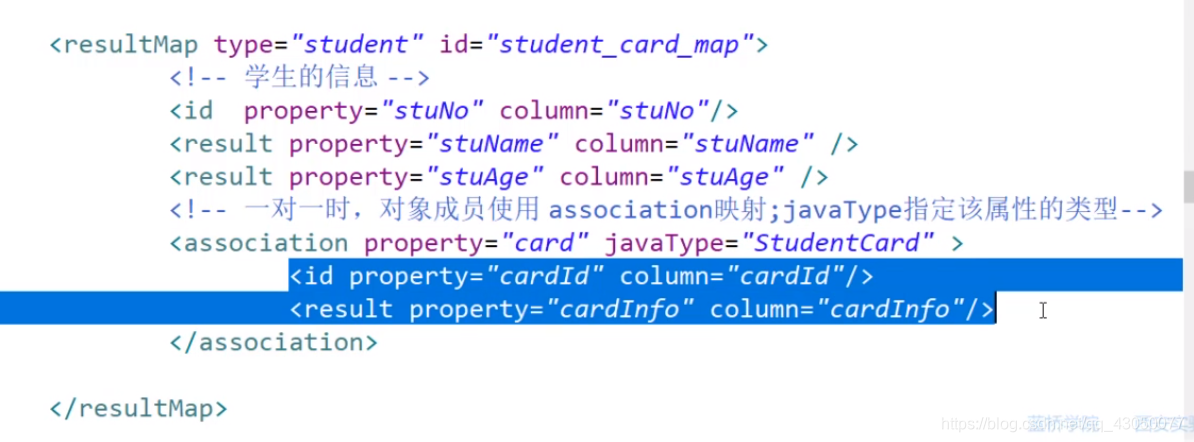(1).简介
- Mybatis处于三层中的dao层,主要用于简化jdbc操作,实现数据的持久化
- Mybatis是ORM(Object Relational Mapping)的一个实现,主要进行对象和表之间的映射(表名和对象名映射,表字段和对象属性映射),另外类似的还有Hibernate
(2).编程步骤
- step1.
- step2.添加Mybatis配置文件
- step3.写实体类
注意:实体类的属性名要与表的字段要求一样 - step4.编写映射文件
(3).基本原理
Mybatis笔记
ResultType和ResultMap
关联查询
1.一对一关联查询
- 业务扩展类(一般一脚鸡肋,适合于小型的)
-----即重新建一个类,它包含需要查询的两个泪的全部属性,然后返回ResultType类型就是这个新类(通常为了简化业务,可以直接用一个类继承一个属性多的,重写属性少的)
- ResultMap(常用)
-----返回类型为ResultMap(例如学生类和学生证类,可以将学生郑类作为学生的一个属性)


一对多关联查询
注意:在Mybatis中,多对多关联可以看成两个一对多的关联
-
表与对象之间的关系

-
映射文件的编写

-

Mybatis整合Log4j、延迟加载
日志
- 配置文件的编写
<configuration>
<properties resource="db.properties"/>
<settings>
<!-- 开启日志,并指定使用的具体日志 -->
<setting name="logImpl" value="LOG4J"/>
</settings>
</configuration>

- 可以通过日志信息,详细的阅读Mybatis的执行情况(观察Mybatis执行的SQl语句、以及SQL中的参数和返回的如果)
延迟加载
- 配置文件
<configuration>
<properties resource="db.properties"/>
<settings>
<!-- 开启日志,并指定使用的具体日志 -->
<setting name="logImpl" value="LOG4J"/>
<!-- 开启延迟加载 -->
<setting name="lazyLoadingEnabled" value="true"/>
<!-- 关闭立即加载 -->
<setting name="aggressiveLazyLoading" value="false"/>
</settings>
<!--
<configuration>
-->
- 映射文件(两个)
<?xml version="1.0" encoding="UTF-8" ?>
<!DOCTYPE mapper
PUBLIC "-//mybatis.org//DTD Mapper 3.0//EN"
"http://mybatis.org/dtd/mybatis-3-mapper.dtd">
<!-- namespace:该mapper.xml映射文件的 唯一标识 -->
<mapper namespace="org.lanqiao.mapper.StudentClassMapper">
<!-- 一对多,带延迟加载 -->
<select id="queryClassAndStudents" resultMap="class_student_lazyLoad_map">
<!-- 11111111先查询班级 -->
select c.* from studentclass c
</select>
<!-- 类-表的对应关系 -->
<resultMap type="studentClass" id="class_student_lazyLoad_map">
<!-- 因为 type的主类是班级,因此先配置班级的信息-->
<id property="classId" column="classId"/>
<result property="className" column="className"/>
<!-- 配置成员属性学生,一对多;属性类型:javaType,属性的元素类型ofType -->
<!-- 2222222再查班级对应的学生 -->
<collection property="students" ofType="student" select="org.lanqiao.mapper.StudentMapper.queryStudentsByClassId" column="classid">
<!-- <id property="stuNo" column="stuNo"/>
<result property="stuName" column="stuName"/>
<result property="stuAge" column="stuAge"/>
-->
</collection>
</resultMap>
</mapper>
第二个映射文件
<?xml version="1.0" encoding="UTF-8" ?>
<!DOCTYPE mapper
PUBLIC "-//mybatis.org//DTD Mapper 3.0//EN"
"http://mybatis.org/dtd/mybatis-3-mapper.dtd">
<!-- namespace:该mapper.xml映射文件的 唯一标识 -->
<mapper namespace="org.lanqiao.mapper.StudentMapper">
<!-- 一对多,延迟加载需要的: 查询班级中的所有学生 -->
<select id="queryStudentsByClassId" parameterType="int" resultType="student">
select * from student where classId = #{
classId}
</select>
<mapper>
查询缓存
-逻辑

- 作用:减少访问数据库的次数,提高性能
一级缓存
范围:同一个SqlSession对象
Mybatis默认开启了一级缓存,如果用同样的SqlSession查询相同的数据,则只会在第一次查询时向数据库发送sql语句,并将查询结果放入到SQLSESSION中(作为缓存存在);后续再次查询同样的对象时,则直接从缓存中查询该对象即可(忽略掉了数据库的访问)
二级缓存
Mybatis自带二级缓:【同一个namespace】生成的mapper对象
注意:namespace的值就是接口的全类名(包名.类名),通过接口可以产生代理对象
Mybatis的逆向操作
(后续有时间了再整理更新)
扫描二维码关注公众号,回复:
13295569 查看本文章

